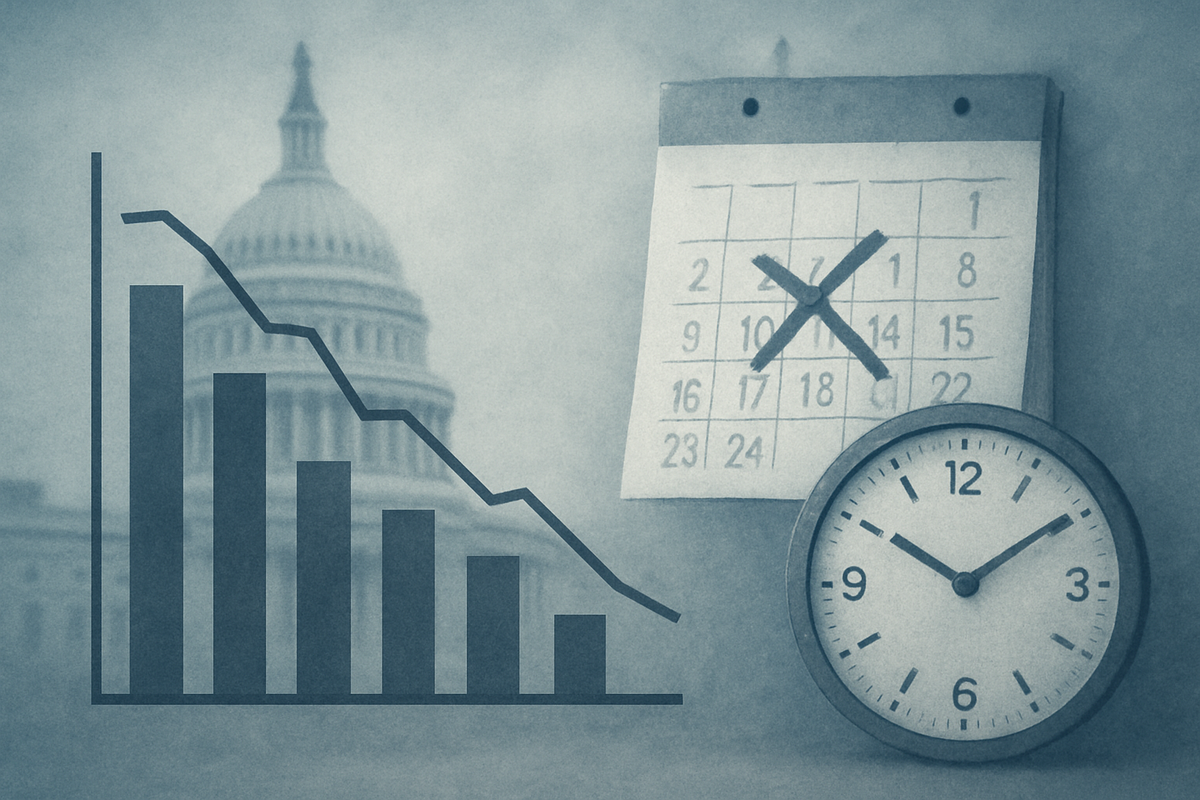
The financial world is holding its breath as crucial US inflation data, previously delayed by a protracted government shutdown, finally sees the light of day. This long-awaited information, particularly the September Consumer Price Index (CPI) and Personal Consumption Expenditures (PCE) price index, is providing the Federal Reserve, businesses, and consumers with a clearer, albeit complex, picture of the nation's economic health. The release comes at a critical juncture, with lingering inflationary pressures, a rebalancing labor market, and a Federal Reserve navigating a delicate path for interest rates, all contributing to heightened market sensitivity. The implications for consumer purchasing power, business investment strategies, and the Fed's monetary policy are profound, setting the stage for potential shifts across the economic landscape.
The Aftermath of a Historic Data Blackout
The recent government shutdown, stretching from October 1st to November 8th, 2025, marked the longest in US history, lasting an unprecedented 39 days. This legislative stalemate, primarily fueled by partisan disputes over federal spending and expiring tax credits, led to the furlough of hundreds of thousands of federal employees. Among the most critical casualties were the operations of key statistical agencies, including the Bureau of Labor Statistics (BLS), responsible for the CPI, and the Bureau of Economic Analysis (BEA), which compiles the PCE index. Data collection for October's inflation reports was largely halted, forcing the BLS to indefinitely postpone the release of the October CPI, originally slated for mid-November.
Throughout October, the absence of official economic data created a "fog of uncertainty" for policymakers and markets. Federal Reserve (The Fed) Chair Jerome Powell publicly acknowledged the increasing difficulty of making data-dependent monetary policy decisions. The Federal Open Market Committee (FOMC) held its late-October meeting, relying on outdated figures, anecdotal evidence, and private-sector estimates to guide its discussions on interest rates. Economists widely warned that this "data blackout" would severely complicate the Fed's ability to assess inflation and employment trends.
Upon the government's reopening on November 8th, 2025, federal agencies began the arduous task of recalling staff and resuming operations. While some September data was quickly processed, the October inflation reports are now officially "upcoming" with revised, later release schedules. Concerns persist about the potential for compromised data quality for October, and whether some data may be permanently lost or simply skipped in favor of future releases, further clouding the immediate economic outlook.
Corporate Fortunes Tied to Inflation's Trajectory
The trajectory of inflation, as revealed by these delayed reports, will significantly shape the fortunes of public companies. Higher-than-expected inflation typically signals an overheated economy, prompting the Federal Reserve to maintain or raise interest rates, which impacts borrowing costs and consumer spending. Conversely, lower-than-expected inflation could encourage the Fed to cut rates, stimulating growth.
In a scenario of higher-than-expected inflation, companies in sectors with strong pricing power or those benefiting from rising commodity prices tend to fare better. This includes energy giants like ExxonMobil (NYSE: XOM) and Chevron (NYSE: CVX), whose profitability is often tied to higher energy costs. Financial institutions such as JPMorgan Chase (NYSE: JPM) and Bank of America (NYSE: BAC) could see increased net interest revenue from higher lending rates. Real estate investment trusts (REITs) like Prologis (NYSE: PLD) might also offer a partial hedge as property values and rental incomes often rise with inflation. However, consumer discretionary companies like Tesla (NASDAQ: TSLA) or luxury brands could struggle as consumer purchasing power erodes and spending shifts towards necessities. Technology and growth stocks, often valued on future earnings, might also see their valuations pressured by higher discount rates.
Conversely, if inflation data indicates lower-than-expected inflation or disinflation, it could signal easing price pressures and potentially lead to a more dovish stance from the Fed, prompting rate cuts. This environment generally favors growth-oriented sectors. Technology behemoths like Apple (NASDAQ: AAPL) and Microsoft (NASDAQ: MSFT) often thrive with lower interest rates, as their future earnings are discounted at a lower rate, boosting their present valuation. Consumer discretionary companies, such as Amazon (NASDAQ: AMZN) and Starbucks (NASDAQ: SBUX), could benefit from increased consumer purchasing power and lower borrowing costs for big-ticket items. Banks, however, might face compressed net interest margins if rates fall too quickly, although increased loan volumes could offset some of this impact.
Broader Economic Canvas: Interconnectedness and Policy Dilemmas
The delayed inflation data, set against the backdrop of a prolonged government shutdown, highlights the deep interconnectedness of the US economy with global trends and the critical role of timely statistical information. This event fits into broader economic trends marked by persistent inflation concerns, fears of an economic slowdown, and the increasing politicization of fiscal policy.
The "data blackout" exacerbated the Federal Reserve's policy dilemma. Already grappling with inflation above its 2% target since early 2021 and facing a bifurcated consumer base (with lower earners struggling), the Fed was forced to make decisions with limited visibility. This uncertainty increases the risk of policy missteps, potentially allowing inflation to become entrenched or hindering necessary economic adjustments. The current shutdown, now the longest in history, has already chipped away at GDP growth, with estimates suggesting a reduction of 0.1 to 0.15 percentage points for each week it lasts.
Globally, the US shutdown and data delay sent ripples of uncertainty. International financial markets, including those in Europe and Asia, often react with "sympathy selling." International trade and supply chains faced disruptions as agencies like the Bureau of Industry and Security (BIS) and the Directorate of Defense Trade Controls (DDTC) curtailed services, impacting businesses engaged in cross-border commerce. Foreign direct investment decisions were likely postponed, and the US dollar experienced fluctuations, with a more dovish Fed potentially weakening the dollar and making emerging markets more attractive. Historically, US government shutdowns have consistently delayed key economic data, impacting everything from jobs reports to social security cost-of-living adjustments (COLA), underscoring the vital nature of uninterrupted government operations for economic stability.
Navigating the Path Ahead: Scenarios and Strategic Shifts
As of November 10, 2025, the US economy stands at a critical juncture, with the trajectory of inflation and the Federal Reserve's response dictating the path forward. Short-term possibilities indicate that while September CPI showed some moderation, underlying pressures, potentially from tariffs and a still-tight labor market, persist. The Fed, having already cut rates in September and October to a target range of 3.75%-4.00%, is now cautiously assessing further moves, with a December pause "far from a foregone conclusion" due to internal FOMC divisions and the recent data scarcity.
Long-term, US inflation is projected to remain above the Fed's 2% target, with tariffs potentially contributing to elevated goods inflation through late 2026. This could even necessitate modest rate hikes in 2026-2027 if inflation accelerates. The labor market, while cooling, still faces challenges, with reduced immigration potentially leading to shortages in service sectors and contributing to supply-side inflation.
Strategic Pivots:
- Federal Reserve: The Fed will maintain a data-dependent, flexible approach, reacting cautiously to incoming data. Transparent communication will be paramount to manage market expectations, and the Fed may need to explicitly consider the inflationary impact of tariffs.
- Businesses: Companies must prioritize supply chain resilience, investing in domestic manufacturing to mitigate tariff impacts. Dynamic pricing strategies and robust cost management will be essential to maintain margins. Adapting value propositions to meet evolving consumer behaviors, especially given increased price sensitivity, is crucial. Investment in AI and other productivity-enhancing technologies like those from Nvidia (NASDAQ: NVDA) or Alphabet (NASDAQ: GOOGL) could offer a competitive edge.
Market Opportunities and Challenges:
- Challenges: Sticky inflation, tariff-driven costs, persistent market volatility, and potential asset price distortions remain significant headwinds. The cumulative impact of inflation since 2020 has severely impacted lower-income households.
- Opportunities: Growth-oriented sectors, particularly technology, could outperform if the Fed continues rate cuts. Real estate investment trusts (REITs) might benefit from moderating interest rates, and the construction industry could see some relief from lower loan rates. Companies investing in productivity enhancements through AI could unlock significant gains. A more rapid disinflation could significantly boost stock markets.
Potential scenarios range from a "soft landing" with gradual disinflation and sustained growth, to "sticky inflation" requiring extended monetary tightness, or even "stagflationary" pressures combining persistent inflation with rising unemployment. The latter, with a 25% recession risk over 12 months, would pose significant challenges for corporate earnings and market stability.
Wrap-Up: Navigating a Complex Economic Terrain
The release of the delayed US inflation data marks a pivotal moment, offering a clearer, yet still challenging, economic outlook. Key takeaways from the recent data point to persistent inflation, with the September CPI and Core CPI both at 3.0% year-over-year, and the Fed's preferred PCE index slightly lower but still above target. These figures underscore the ongoing struggle to achieve price stability amidst various economic crosscurrents.
Moving forward, the market will remain intensely focused on the Federal Reserve's actions. While futures markets price in potential rate cuts in early 2026, the Fed's "data-dependent" stance means any unexpected shifts in inflation or employment could alter this trajectory. Equities will experience sector rotation, with energy and financials potentially benefiting from higher rates or commodity prices, while technology and consumer discretionary sectors might thrive in a lower-rate environment. Fixed income markets will react to yield fluctuations, and the US dollar's strength will be influenced by the Fed's hawkish or dovish leanings.
The significance of inflation data extends beyond immediate market reactions; it fundamentally impacts consumer purchasing power, the credibility of monetary policy, and long-term economic growth. Persistently high inflation can erode wealth and constrain business investment, while a successful return to the Fed's 2% target could usher in a period of more stable growth.
What Investors Should Watch For in Coming Months:
- Inflation Data: Closely monitor both headline and core CPI and PCE reports for month-over-month and year-over-year trends, paying particular attention to sticky components like services and shelter.
- Federal Reserve Communication: Analyze statements from Fed officials, including the FOMC's Summary of Economic Projections (SEP) and the "dot plot," for clues on future interest rate policy.
- Labor Market Data: Keep an eye on unemployment rates, job creation, and wage growth as these heavily influence the Fed's dual mandate.
- Economic Growth Indicators: GDP reports, manufacturing data, and consumer spending figures will provide context on the overall health of the economy. A significant slowdown could push the Fed towards rate cuts, even if inflation remains slightly elevated.
- Geopolitical Developments: Global events and trade policies, such as new tariffs, can significantly impact supply chains and commodity prices (like oil), potentially reigniting inflationary pressures.
- Inflation Expectations: Monitor both survey-based (e.g., University of Michigan, New York Fed) and market-based inflation expectations. These can be self-fulfilling prophecies, influencing consumer and business decisions.
Final Thoughts and Investor Advice: The period spanning late 2025 through 2026 is expected to be a transition toward a more complex financial environment, moving away from past accommodative conditions. Investors should anticipate continued market volatility. JPMorgan's 2026 outlook suggests a slower but stronger bull run for equities, with potential 6-7% annual returns for global equities, driven by AI, automation, and economic nationalism. They advise investors to "buy dips, stay diversified, and think long term," recommending a mix of equities, fixed income, and alternatives across regions and sectors. Portfolio resilience and strategic diversification, incorporating geopolitical risk, will be paramount. Companies with strong pricing power and the ability to manage rising input costs are likely to fare better. While short-term pullbacks may occur, record amounts of cash in money market funds suggest that these dips might be bought, indicating underlying investor confidence in the long-term trajectory. The Fed's balancing act between controlling inflation and supporting employment will be central to market movements.
This content is intended for informational purposes only and is not financial advice





